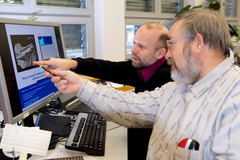Jan 17 2014
Chemical reactions will change the nature of the deep repository and the surrounding rock (clay rock); that much is certain. But to what extent and with what impact on safety? Researchers from the Paul Scherrer Institute are looking to answer this question with the aid of a combination of experiments and computer simulations.
 Georg Kosakowski and Urs Berner (Photo: Paul Scherrer Institute/Frank Reiser)
Georg Kosakowski and Urs Berner (Photo: Paul Scherrer Institute/Frank Reiser)
In Switzerland, radioactive waste from nuclear power plants, research facilities, hospitals and other sources has to be disposed of in deep geological repositories in accordance with the nuclear energy law. The waste – be it low or medium-active, as is the case from research, or highly active like fuel elements used in nuclear power plants – is supposed to be enclosed safely in these deep repositories for 100,000 to 1,000,000 years, which should prevent radionuclides from entering the biosphere at concentrations above the permitted limit via the groundwater. Consequently, it is important to understand which geochemical and physical processes take place in a deep repository to enable us to make reliable predictions regarding their safety over such long periods of time.
Following nature’s lead
Chemical reactions will change the nature of the deep repository and the surrounding rock (clay rock); that much is certain. But to what extent and with what impact on safety?
Researchers from the Paul Scherrer Institute are looking to answer this question with the aid of a combination of experiments and computer simulations. Compared to experiments the calculations have one major advantage: they include both extremely short and extremely long periods of time, which enables very slow processes to be studied that are not accessible in experiments in a rock laboratory.
Apart from the simulations, the researchers also rely on so-called natural analogues, by which the experts mean naturally occurring geological environments where similar processes to those in a deep repository take place. Moreover, these natural analogues often provide a valuable insight into the future, i.e. the probable development of a deep repository.
One such natural analogue is located in Maqarin in Northern Jordan, near the Syrian border. There, combustion processes have been initiated in the highly bituminous rocks, the exact causes of which are still unknown. The heat released from those processes has transformed the local calciferous rock into cement-like rock formations. Rainwater then seeped through the rocks, leached the cement, escaped through cracks and came into contact with the surrounding clay rock. Due to its high pH level, cement is highly alkaline while clay rock is almost pH-neutral. As clay is thus practically an acid compared to cement, a neutralising chemical reaction took place after mixing between the “lye water” and the clay rock.
Minerals seal the pores
A similar acid-alkali reaction also takes place in a deep geological repository for low-active waste. “Acidic” clay rock and alkaline water from the cement covering the shaft walls and caverns of the deep repository also come into contact with each other. Although researchers are aware that cement and clay rock neutralise each other in the process, the reaction mostly takes place extremely slowly.
In Maqarin, scientists have observed that minerals such as calcite and ettringite are formed in the course of the neutralising reactions and cause the pores in the clay rock to close up almost completely at a distance of a few millimetres from the contact. The time it takes for the pores to close up is still unclear. However, it seems that it won’t take longer than a few centuries, as computer simulations conducted by the PSI researchers Georg Kosakowski and Urs Berner suggest. In other words, this would mean that the acid-alkali reaction makes the deep repository safer within a relatively short space of time as pores are sealed, making it more difficult for radionuclides to escape.
A milestone in understanding deep repositories
The PSI researchers regard the fact that the observations from Maqarin’s “natural lab” agree well with the results of their computer simulations as a major milestone on the path towards understanding deep repositories better. The good correlation with the data measured is a proof of their calculation model, in which they investigated the complexity of the geochemical reactions combined with details of the water transport (mainly diffusion) in the rock mathematically.